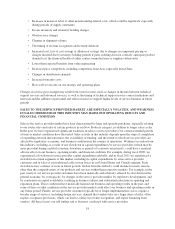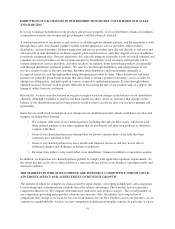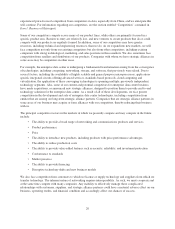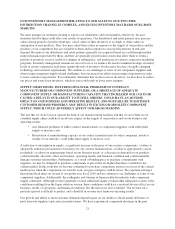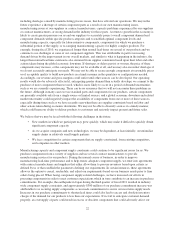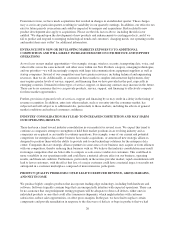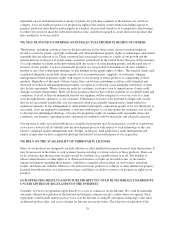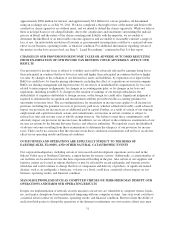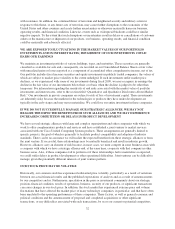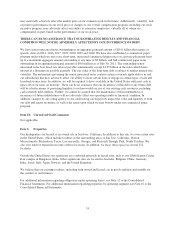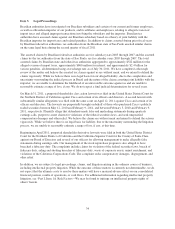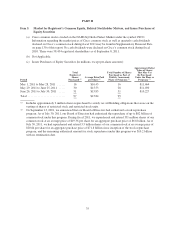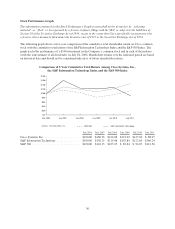Cisco 2011 Annual Report Download - page 36
Download and view the complete annual report
Please find page 36 of the 2011 Cisco annual report below. You can navigate through the pages in the report by either clicking on the pages listed below, or by using the keyword search tool below to find specific information within the annual report.Our exposure to the credit risks relating to our financing activities described above may increase if our customers
are adversely affected by a global economic downturn or periods of economic uncertainty. Although we have
programs in place that are designed to monitor and mitigate the associated risk, including monitoring of
particular risks in certain geographic areas, there can be no assurance that such programs will be effective in
reducing our credit risks.
In the past, there have been significant bankruptcies among customers both on open credit and with loan or lease
financing arrangements, particularly among Internet businesses and service providers, causing us to incur
economic or financial losses. There can be no assurance that additional losses will not be incurred. Although
these losses have not been material to date, future losses, if incurred, could harm our business and have a material
adverse effect on our operating results and financial condition. A portion of our sales is derived through our
distributors and retail partners. These distributors and retail partners are generally given business terms that allow
them to return a portion of inventory, receive credits for changes in selling prices, and participate in various
cooperative marketing programs. We maintain estimated accruals and allowances for such business terms.
However, distributors tend to have more limited financial resources than other resellers and end-user customers
and therefore represent potential sources of increased credit risk, because they may be more likely to lack the
reserve resources to meet payment obligations. Additionally, to the degree that turmoil in the credit markets
makes it more difficult for some customers to obtain financing, those customers’ ability to pay could be
adversely impacted, which in turn could have a material adverse impact on our business, operating results, and
financial condition.
WE ARE EXPOSED TO FLUCTUATIONS IN CURRENCY EXCHANGE RATES THAT COULD
NEGATIVELY IMPACT OUR FINANCIAL RESULTS AND CASH FLOWS
Because a significant portion of our business is conducted outside the United States, we face exposure to adverse
movements in foreign currency exchange rates. These exposures may change over time as business practices
evolve, and they could have a material adverse impact on our financial results and cash flows. Historically, our
primary exposures have related to nondollar-denominated sales in Japan, Canada, and Australia and certain
nondollar-denominated operating expenses and service cost of sales in Europe, Latin America, and Asia, where
we sell primarily in U.S. dollars. Additionally, we have exposures to emerging market currencies, which can
have extreme currency volatility. An increase in the value of the dollar could increase the real cost to our
customers of our products in those markets outside the United States where we sell in dollars, and a weakened
dollar could increase the cost of local operating expenses and procurement of raw materials to the extent that we
must purchase components in foreign currencies.
Currently, we enter into foreign exchange forward contracts and options to reduce the short-term impact of
foreign currency fluctuations on certain foreign currency receivables, investments, and payables. In addition, we
periodically hedge anticipated foreign currency cash flows. Our attempts to hedge against these risks may not be
successful, resulting in an adverse impact on our net income.
OUR PROPRIETARY RIGHTS MAY PROVE DIFFICULT TO ENFORCE
We generally rely on patents, copyrights, trademarks, and trade secret laws to establish and maintain proprietary
rights in our technology and products. Although we have been issued numerous patents and other patent
applications are currently pending, there can be no assurance that any of these patents or other proprietary rights
will not be challenged, invalidated, or circumvented or that our rights will, in fact, provide competitive
advantages to us. Furthermore, many key aspects of networking technology are governed by industrywide
standards, which are usable by all market entrants. In addition, there can be no assurance that patents will be
issued from pending applications or that claims allowed on any patents will be sufficiently broad to protect our
technology. In addition, the laws of some foreign countries may not protect our proprietary rights to the same
extent as do the laws of the United States. The outcome of any actions taken in these foreign countries may be
different than if such actions were determined under the laws of the United States. Although we are not
28


